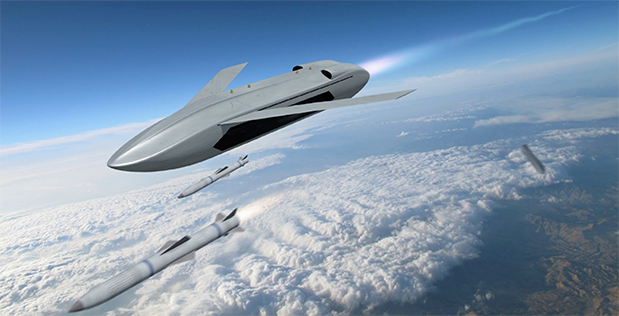Development of a new breed of unmanned aircraft is now underway, as three major defense companies earned contracts to start designing a future system known as “LongShot.”
The LongShot program wants to create an unmanned weapons porter that can be shot from another plane before firing multiple air-to-air missiles itself, according to the Defense Advanced Research Projects Agency, which runs the effort.
DARPA announced Feb. 8 it has funded General Atomics, Lockheed Martin, and Northrop Grumman to start design work in the project’s first phase, but did not disclose how much money is part of those contracts.
“The objective is to develop a novel [unmanned air vehicle] that can significantly extend engagement ranges, increase mission effectiveness, and reduce the risk to manned aircraft,” DARPA said in a release. “It is envisioned that LongShot will increase the survivability of manned platforms by allowing them to be at standoff ranges far away from enemy threats, while an air-launched LongShot UAV efficiently closes the gap to take more effective missile shots.”
The project first appeared in DARPA’s fiscal 2021 budget request as a prospective addition to the Air Force and Navy’s inventories. The budget called for a plane that uses “multi-mode propulsion” to tackle multiple airborne threats at once, Air Force Magazine previously reported.
The program called for $22 million in its first year.
“LongShot will explore new engagement concepts for multi-modal, multi-kill systems that can engage more than one target,” DARPA wrote. “LongShot can be deployed either externally from existing fighters or internally from existing bombers.”
Last year, the research agency suggested the aircraft could fly slowly toward its target at first to save fuel, then speed up once it gets close.
“This approach provides several key benefits,” DARPA said. “First, the weapon system will have a much-increased range over their legacy counterparts for transit to an engagement zone. Second, launching air-to-air missiles closer to the adversary increases energy in terminal flight, reduces reaction time, and increases probability of kill.”
The Pentagon hasn’t said what weapons LongShot would carry, or how autonomous its software might be. On paper, LongShot appears similar to other efforts like the Air Force’s previous Gray Wolf missile program, which looked to create a munition that could carry other weapons inside. That was discontinued in favor of the service’s Golden Horde swarming bomb project.
Later in the LongShot program, DARPA said, the companies will fly a full-scale prototype that is “capable of controlled flight before, during, and after” it is fired. The agency did not immediately answer how long the initial design phase will last.
The fiscal 2021 budget also called for a new program entitled “Gunslinger,” a new air-launched missile armed with a gun that would be designed for Air Force and Navy missions. But that appears to have a murkier future than the LongShot.
“The Gunslinger program has yet to formally launch and, at this time, we have no information on when that may happen,” DARPA spokesman Jared Adams said in December.
